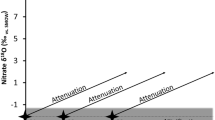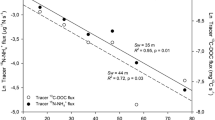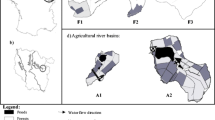Abstract
Russian olive (Elaeagnus angustifolia) is a non-native riparian tree that has become common and continues to rapidly spread throughout the western United States. Due to its dinitrogen (N2)-fixing ability and proximity to streams, Russian olive has the potential to subsidize stream ecosystems with nitrogen (N), which may in turn alter nutrient processing in these systems. We tested these potential effects by comparing background N concentrations; nutrient limitation of biofilms; and uptake of ammonium (NH4-N), nitrate (NO3-N), and phosphate (PO4-P) in paired upstream-reference and downstream-invaded reaches in streams in southeastern Idaho and central Wyoming. We found that stream reaches invaded by Russian olive had higher organic N concentrations and exhibited reduced N limitation of biofilms compared to reference reaches. However, at low inorganic N background concentrations, reaches invaded by Russian olive exhibited higher demand for both NH4-N and NO3-N compared to their paired reference reaches, suggesting these streams have the potential to retain the N subsidy from Russian olive N2 fixation and diminish its downstream export and effects. Our findings demonstrate the potential for a non-native riparian plant to significantly alter biogeochemical cycling in streams. Finally, we used our results to develop a conceptual model that describes predicted effects of Russian olive and other non-native riparian N2 fixers on in-stream N dynamics.




Similar content being viewed by others
References
Allos HF, Bartholomew WV. 1959. Replacement of symbiotic fixation by available nitrogen. Soil Sci 87:61–6.
American Public Health Association. 2005. Standard methods for the examination of water and wastewater. Washington DC: American Public Health Association.
Baer SG, Church JM, Williard KWJ, Groninger JW. 2006. Changes in intrasystem N cycling from N2-fixing shrub encroachment in grassland: multiple positive feedbacks. Agric Ecosyst Environ 115:174–82.
Barton BJ. 2004. Surface- and ground-water relations on the Portneuf River, and temporal changes in ground-water levels in the Portneuf Valley, Caribou and Bannock counties, Idaho, 2001–02. USGS Report 2004-5170.
Baxter CV, Fausch KD, Murakami M, Chapman PL. 2004. Fish invasion restructures stream and forest food webs by interrupting reciprocal prey subsidies. Ecology 85:2656–63.
Baxter CV, Fausch KD, Saunders WC. 2005. Tangled webs: reciprocal flows of invertebrate prey link streams and riparian zones. Freshw Biol 50:201–20.
Bernhardt ES, Likens GE. 2002. Dissolved organic carbon enrichment alters nitrogen dynamics in a forest stream. Ecology 83:1689–700.
Bernot MJ, Dodds WK. 2005. Nitrogen retention, removal, and saturation in lotic ecosystems. Ecosystems 8:442–53.
Boyer EW, Goodale CL, Jaworski NA, Howorth RW. 2002. Anthropogenic sources and relationships to riverine nitrogen export in the northeastern U.S.A. Biogeochemistry 57(58):137–69.
Brookshire ENJ, Valett HM, Thomas SA, Webster JR. 2005. Coupled cycling of dissolved organic nitrogen and carbon in a forest stream. Ecology 86:2487–96.
Brookshire ENJ, Valett HM, Thomas SA, Webster JR. 2007. Atmospheric N deposition increases organic N loss from temperate forests. Ecosystems 10:252–62.
Chapin FS, Mooney HA, Chapin MC, Matson P. 2002. Principles of terrestrial ecosystem ecology. New York, NY: Springer.
Compton JE, Church MR, Larned ST, Hogsett WE. 2003. Nitrogen export from forested watersheds in the Oregon Coast Range: the role of N2-fixing red alder. Ecosystems 6:773–85.
Costello DM, Lamberti GA. 2008. Non-native earthworms in riparian soils increase nitrogen flux into adjacent aquatic ecosystems. Oecologia 158:499–510.
Dahm CN, Grimm NB, Marmonier P, Valett HM, Vervier P. 1998. Nutrient dynamics at the interface between surface waters and groundwaters. Freshw Biol 40:427–51.
DeCant JP. 2008. Russian olive, Elaeagnus angustifolia, alters patterns in soil nitrogen pools along the Rio Grande River, New Mexico, USA. Wetlands 28:896–904.
Dent CL, Grimm NB, Fisher SG. 2000. Multiscale effects of surface–subsurface exchange on stream water nutrient concentrations. J N Am Benthol Soc 20:162–81.
Earl SR, Valett HM, Webster JR. 2006. Nitrogen saturation in stream ecosystems. Ecology 87:3140–51.
Elser JJ, Bracken MES, Cleland EE, Gruner DS, Harpole WS, Hillebrand H, Ngai JT, Seabloom EW, Shurin JB, Smith JE. 2007. Global analysis of nitrogen and phosphorus limitation of primary producers in freshwater, marine and terrestrial ecosystems. Ecol Lett 10:1135–42.
Fisher SG. 2006. Stream ecosystems of the western United States. In: Cushing CE, Cummins KW, Minshall GW, Eds. River and stream ecosystems of the world. Berkley, California: University of California Press. p 61–87.
Follstad Shah JJ, Harner MJ, Tibbets TM. 2010. Elaeagnus angustifolia elevates soil inorganic nitrogen pools in riparian ecosytems. Ecosystems 13:46–61.
Forseth IN, Innis AF. 2004. Kudzu (Pueraria montana): history, physiology and ecology combine to make a major ecosystem threat. Crit Rev Plant Sci 23:401–13.
Friedman JM, Auble GT, Shafroth PB, Scott ML, Merigliano MF, Preehling MD, Griffin EK. 2005. Dominance of non-native riparian trees in western USA. Biol Invasions 7:747–51.
Frissell CA, Liss WJ, Warren CE, Hurley MD. 1986. A hierarchical framework for stream habitat classification: Viewing streams in a watershed context. Environ Manag 10:199–214.
Galloway JN, Dentener FJ, Capone DG, Boyer EW, Howorth RW, Seitzinger SP, Asner GP, Cleveland CC, Green PA, Holland EA, Karl DM, Micheals AF, Porter JH, Townsend AR, Vörösmarty CJ. 2004. Nitrogen cycles: past, present and future. Biogeochemistry 70:153–226.
Gibeau GG, Miller MC. 1989. Micro-bioassay for epilithon using nutrient-diffusing artificial substrata. J Freshw Ecol 5:171–6.
Goldman CR. 1961. The contribution of alder trees (Alnus tenuifolia) to the primary production of Castle Lake. Calif Ecol 42:282–8.
Goodale CL, Aber JD, McDowell WH. 2000. The long-term effects of disturbance on organic and inorganic nitrogen export in the White Mountains, New Hampshire. Ecosystems 3:433–50.
Gregory SV, Sawanson FJ, McKee WA, Cummins KW. 1991. An ecosystem perspective of riparian zones. Bioscience 41:540–51.
Grimm NB, Petrone KC. 1997. Nitrogen fixation in a desert stream ecosystem. Biogeochemistry 37:33–61.
Groffman PM, Boulware NJ, Zipperer WC, Pouyat RV, Band LE, Colosimo MF. 2002. Soil nitrogen cycle processes in urban riparian zones. Environ Sci Technol 36:4547–52.
Hall RO, Tank JL, Sobota DJ, Mulholland PJ, O’Brien JM, Dodds WK, Webster JR, Valett HM, Poole GC, Peterson BJ, Meyer JL, McDowell WH, Johnson SL, Hamilton SK, Grimm NB, Gregory SV, Dahm CN, Cooper LW, Ashkenas LR, Thomas SM, Sheibley RW, Potter JD, Niederlehner BR, Johnson LT, Helton AM, Crenshaw CM, Burgin AJ, Bernot MJ, Beaulieu JJ, Arango CP. 2009. Nitrate removal in stream ecosystems measured by 15N addition experiments: total uptake. Limnol Oceanogr 54:653–65.
Harner MJ, Crenshaw CL, Abelho M, Stursova M, Follstad Shah JJ, Sinsabaugh RL. 2009. Decomposition of leaf litter from a native tree and an actinorhizal invasive across riparian habitats. Ecol Appl 19:1135–46.
Hedin LO, Von Fischer JC, Ostrom NE, Kennedy BP, Brown MG, Robertson GP. 1998. Thermoynamic constraints on nitrogen transformations and other biogeochemical processes at soil-stream interfaces. Ecology 79:684–703.
Holmes RM, Aminot A, Kerouel R, Hooker BA, Peterson BJ. 1999. A simple and precise method for measuring ammonium in marine and freshwater ecosystems. Can J Fish Aquat Sci 56:1801–8.
Howarth RW, Billen G, Swaney D, Townsend A, Jaworski N, Lajtha K, Downing JA, Elmgren R, Caraco N, Jordan T, Berendse F, Freney J, Kudeyarov V, Murdoch P, Zhao-Liang Z. 1996. Regional nitrogen budgets and riverine N & P fluxes for the drainages to the North Atlantic Ocean: natural and human influences. Biogeochemistry 35:75–139.
Howe WH, Knopf FL. 1991. On the imminent decline of Rio Grande cottonwoods in central New Mexico. Southwest Nat 36:218–24.
Johnson LT, Tank JL, Arango CP. 2009. The effect of land use on dissolved organic carbon and nitrogen uptake in streams. Freshw Biol 54:2335–50.
Katz GL, Shafroth PB. 2003. Biology, ecology and management of Elaeagnus angustifolia L. (Russian olive) in western North America. Wetlands 23:763–77.
Lesica P, Miles S. 1999. Russian olive invasion into cottonwood forests along a regulated river in north-central Montana. Can J Bot 77:1077–83.
Lonsdale WM. 1993. Rates of spread of an invading species—Mimosa pigra in northern Australia. J Ecol 81:513–21.
Marcarelli AM, Baker MA, Wurtsbaugh WA. 2008. Is in-stream N2 fixation an important N source for benthic communities and stream ecosystems? J N Am Benthol Soc 27:186–211.
Marcarelli AM, Bechtold HA, Rugenski AT, Inouye RS. 2009. Nutrient limitation of biofilm biomass and metabolism in the Upper Snake River basin, southeast Idaho, USA. Hydrobiologia 620:63–76.
Marchante H, Marchante E, Freitas H. 2003. Invasion of the Portuguese dune ecosystems by the exotic species Acacia longifolia (Andrews) Willd.: effects at the community level. In: Child LE, Brock JH, Brundu G, Prach K, Pysek P, Wade PM, Williamson M, Eds. Plant invasions: ecological threats and management solutions. Leiden, The Netherlands: Backhuys Publishers. p 75–85.
Maron JL, Estes JA, Croll DA, Danner EM, Elmendorf SC, Buckelew SL. 2006. An introduced predator alters Aleutian Island plant communities by thwarting nutrient subsidies. Ecol Monogr 76:3–24.
Miller IM, Baker DD. 1985. The initiation, development and structure of root nodules in Elaeagnus angustifolia L. (Elaeagnaceae). Protoplasma 128:107–19.
Mineau MM. 2010. The effects of Russian olive (Elaeagnus angustifolia) invasion on stream nitrogen cycling, organic matter dynamics, and food webs. Doctoral dissertation, Idaho State University.
Mulholland PJ. 1992. Regulation of nutrient concentrations in a temperate forest stream: roles of upland, riparian, and instream processes. Limnol Oceanogr 37:1512–26.
Naiman RJ, Décamps H. 1997. The ecology of interfaces: riparian zones. Annu Rev Ecol Syst 28:621–58.
Neff JC, Chapin FS, Vitousek PM. 2003. Breaks in the cycle: dissolved organic nitrogen in terrestrial ecosystems. Front Ecol Environ 1:205–11.
Nydahl F. 1976. On the optimum conditions for the reduction of nitrate by cadmium. Talanta 23:349.
Olson TE, Knopf FL. 1986. Naturalization of Russian-olive in the western United States. West J Appl For 1:65–9.
Perakis SS, Hedin LS. 2002. Nitrogen loss from unpolluted South American forests mainly via dissolved organic compounds. Nature 415:416–19.
Peterjohn WT, Correll DL. 1984. Nutrient dynamics in an agricultural watershed: observations on the role of a riparian forest. Ecology 65:1466–75.
Poff NL, Allan JD, Bain MB, Karr JR, Prestegaard KL, Richter BD, Sparks RE, Stromberg JC. 1997. The natural flow regime: a paradigm for river conservation and restoration. Bioscience 11:769–84.
Roggy JC, Moiroud A, Lensi A, Domenach AM. 2004. Estimating N transfers between N2-fixing actinorhizal species and the non-N2-fixing Prunus avium under partially controlled conditions. Biol Fertil Soils 39:312–19.
Royer TV, Monaghan MT, Minshall GW. 1999. Processing of native and exotic leaf litter in two Idaho (USA) streams. Hydrobiologia 400:123–8.
Sanderson BL, Coe HJ, Tran CD, Macneale KH, Harstad DL, Goodwin AB. 2009. Nutrient limitation of periphyton in Idaho streams: results from nutrient diffusing substrate experiments. J N Am Benthol Soc 28:832–45.
Schade JD, Fisher SG, Grimm NB, Seddon JA. 2001. The influence of a riparian shrub on nitrogen cycling in a Sonoran desert stream. Ecology 82:3363–76.
Simons SB, Seastedt TR. 1999. Decomposition and nitrogen release from foliage of cottonwood (Populus deltoides) and Russian-olive (Elaeagnus angustifolia) in a riparian ecosystem. Southwest Nat 44:256–60.
Stock WD, Wienand KT, Baker AC. 1995. Impacts of invading N2-fixing Acacia species on patterns of nutrient cycling in two Cape ecosystems: evidence from soil incubation studies and 15N natural abundance values. Oecologia 101:375–82.
Stoddard JL. 1994. Long-term changes in watershed retention of nitrogen: its causes and aquatic consequences. Adv Chem Ser 237:223–84.
Swanson RB, Miller KA, Woodruff RE, Laidlaw GA, Watson KR, Clark ML. 2002. Water resources data Wyoming water year 2002. USGS report WY-02-1.
Tank JL, Bernot MJ, Rosi-Marshall EJ. 2006. Nitrogen limitation and uptake. In: Hauer FR, Lamberti GA, Eds. Methods in stream ecology. San Diego, California: Academic Press. p 213–38.
Tank JL, Dodds WK. 2003. Nutrient limitation of epilithic and epixylic biofilms in ten North American streams. Freshw Biol 48:1031–49.
Taylor BW, Keep CF, Hall RO, Koch BJ, Tronstad LM, Flecker AS, Ulseth AJ. 2007. Improving the fluorometric ammonium method: matrix effects, background fluorescence, and standard additions. J N Am Benthol Soc 26:167–177.
Triska FJ, Duff JH, Avanzino RJ. 1993. The role of water exchange between a stream channel and its hyporheic zone in nitrogen cycling at the terrestrial-aquatic interface. Hydrobiologia 251:167–84.
USDA. 2010. Plants database. U.S. Department of Agriculture Natural Resources Conservation Service. http://plants.usda.-gov/.
Valderama JC. 1981. The simultaneous analysis of total nitrogen and total phosphorus in natural waters. Mar Chem 10:109–22.
Vitousek PM, Walker LR. 1989. Biological invasion by Myrica Faya in Hawai’i: plant demography, nitrogen fixation, ecosystem effects. Ecol Monogr 59:247–65.
Wallace JB, Eggert SL, Meyer JL, Webster JR. 1997. Multiple trophic levels of a forest stream linked to terrestrial litter inputs. Science 277:102–4.
Zhang X, Liu X, Zhang M, Dalhgren RA, Eitzel M. 2010. A review of vegetated buffers and a meta-analysis of their mitigation efficiency in reducing nonpoint source pollution. J Environ Qual 39:76–84.
Acknowledgments
We would like to thank all private land owners who granted us access to many of our study sites as well as the U.S. Forest Service, Bureau of Reclamation, and Shoshone-Bannock Tribe of Fort Hall for additional site access. We sincerely thank The Nature Conservancy of Wyoming for providing housing while we were conducting research in WY. We thank Teresa Tibbets who was instrumental in site selection in WY and reviewed an earlier draft of this manuscript for her help and encouragement. Thanks to Richard Inouye, G. Wayne Minshall and two anonymous reviewers for helpful reviews of this manuscript. We thank Jessica Lueders-Dumont, Hannah Harris, Jennifer Cornell, Tiffany Cook, Tyler Auck, J. Ryan Bellmore, Rebecca Martin, and Amanda Rugenski for their assistance in the field and laboratory. Ian Washbourne at USU performed laboratory chemistry analyses. Funding for this research was provided by NSF EPSCoR in Idaho (EPS-0447689 and EPS-08-14387) and NSF DDIG (Grant # 0910367).
Author information
Authors and Affiliations
Corresponding author
Additional information
Author Contributions
MMM, CVB and AMM designed the study; MMM performed research and data analysis; MMM, CVB, and AMM wrote the paper.
Electronic supplementary material
Below is the link to the electronic supplementary material.
Rights and permissions
About this article
Cite this article
Mineau, M.M., Baxter, C.V. & Marcarelli, A.M. A Non-Native Riparian Tree (Elaeagnus angustifolia) Changes Nutrient Dynamics in Streams. Ecosystems 14, 353–365 (2011). https://doi.org/10.1007/s10021-011-9415-0
Received:
Accepted:
Published:
Issue Date:
DOI: https://doi.org/10.1007/s10021-011-9415-0




